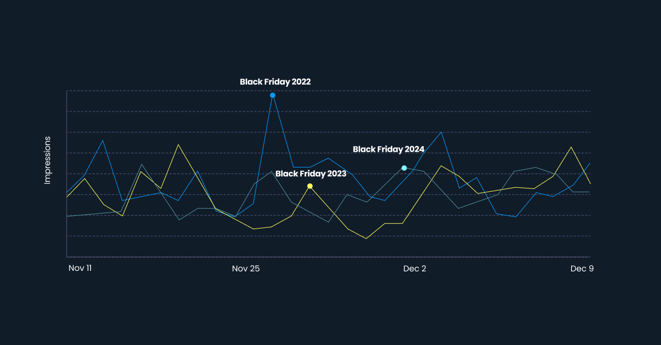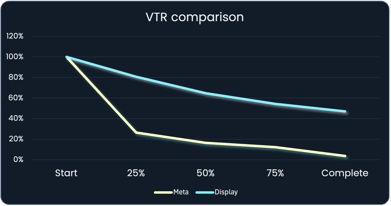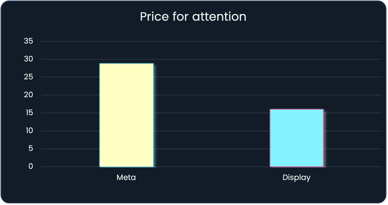What you’re getting wrong about Black Friday advertising
Black Friday used to be synonymous with peak ad pressure - the one week every year when every brand fought for attention. But our data shows that this narrative doesn’t always hold up. Read on to discover what truly matters, guided by data rather than assumptions.
Ad pressure during peak season might be a myth
We analysed the impression data of thousands of display ad campaigns that ran in November and December in the years 2022, 2023 and 2024. Only in 2022 could we spot a clear spike in impressions during week 48, the week of Black Friday.
Since 2022, there’s been no sign of extraordinary ad volume - advertising pressure for the rest of November and December has stayed consistent with the week of Black Friday. That doesn’t mean competition disappears, but the idea that you cannot “cut through the noise” needs to be challenged.

Holiday shopping is shifting earlier
Ad costs and bid competition frequently peak earlier in November, rather than during week 48. Pressure is now more evenly distributed, creating timing opportunities for brands that plan intelligently. Campaigns that start earlier can reach shoppers, and platforms report that multi-week strategies are increasingly effective for both awareness and conversion.
Think going "social-first" wins? Think again
Many advertisers assume that promoting Black Friday deals on social platforms like Meta is the most effective route - after all, social feeds are full of consumers ready to scroll and shop, right? But our latest attention data suggests that this assumption doesn’t hold up under scrutiny.
In the rush to secure quick reach and low CPMs, marketers often overlook the true cost of meaningful engagement. Social feeds are built for speed - endless scrolls, rapid consumption, and fleeting glances. That environment drives volume, but not necessarily attention. When we compare the same creatives on Meta’s in-feed video formats versus high impact video display formats on the open internet, a different story emerges.
In a recent case study across three major food brands, Adnami’s high impact video formats delivered up to 7× longer time in view, 7.6× higher 3-second view rates, and up to 87% cheaper attentive CPMs than Meta’s in-feed video. In other words, while Meta may seem cheaper at first glance, advertisers pay significantly more per second of actual attention.


This pattern echoes what we consistently see in our platform comparisons. According to our data, publishers across the open web routinely deliver a lower cost per 3-second view - a far more telling metric than simple CPMs or video starts. Brands want people to actually watch the ad for at least a few seconds, not just scroll past it.
So, while social platforms may still feel like the “safe” choice for high-profile shopping events, the open internet is where sustained attention, longer ad views, and real brand impact happen. As we approach another Black Friday season, the smartest advertisers will be those who question their assumptions and invest where attention truly lasts.
How to turn this into your advantage
Standing out with attention-grabbing creatives
Brands that prioritise value, storytelling, and creative quality over sheer volume consistently outperform competitors during the holiday season. In fact, research shows that 47% of a campaign’s sales impact comes from the creative execution itself. Your choice of visuals, narrative, and format can make or break performance. Immersive high impact formats are particularly effective, offering a large canvas for creativity.
High impact formats come in a range of engaging layouts, from Desktop Skins that wrap around entire webpages to Mobile Midscrolls that command most of a phone screen, or in-stream video that combines motion and interactivity. They’re beautiful, responsive, and built for performance, enabling brands to deliver fully interactive, shoppable video experiences that convert attention into action.
And if time or resources are tight, creative production services can help. From concept ideation and design to final build and execution, these services ensure your campaign looks premium and performs flawlessly - even under tight timelines. If you already have assets on hand from other platforms and layouts in mind, build-only services can quickly bring your designs to life using responsive HTML5 banners optimised for all devices.
Video is king for attention, storytelling and recall
From analysing over 50,000 video campaigns, we’ve learned that video creatives consistently outperform static images in building brand awareness and capturing attention:
- Streamed video ads deliver 50% more attention than image ads
- Video drives emotional resonance and brand recall, making it ideal for storytelling and brand-building campaigns.
- Motion and immersive formats help messages stick, with vertical, full-screen mobile formats generating the highest engagement
While image ads often outperform video in click-through rates (0.35% vs 0.3%), video is unmatched when it comes to creating memorable, long-term impact. Combining video for awareness with image ads for conversions allows brands to cover the full customer journey.
Conclusion
Black Friday advertising has evolved into a multi-week, multi-format landscape. By challenging assumptions, leveraging data-driven insights, and combining high impact video with performance-driven image ads, brands can capture attention, boost recall, and drive conversions - even when competitors pause. Multi-channel strategies, early timing, and premium placements can maximise impact while managing costs effectively.


